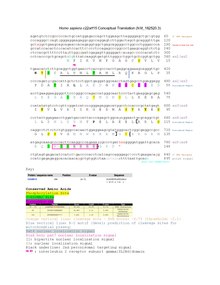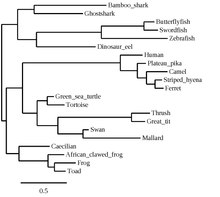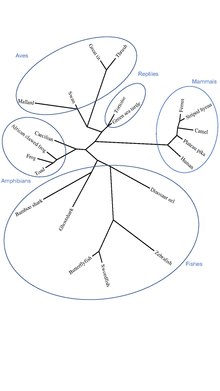
Chromosome 13 is one of the 23 pairs of chromosomes in humans. People normally have two copies of this chromosome. Chromosome 13 spans about 113 million base pairs and represents between 3.5 and 4% of the total DNA in cells.

Chromosome 17 is one of the 23 pairs of chromosomes in humans. People normally have two copies of this chromosome. Chromosome 17 spans more than 84 million base pairs and represents between 2.5 and 3% of the total DNA in cells.

METTL26, previously designated C16orf13, is a protein-coding gene for Methyltransferase Like 26, also known as JFP2. Though the function of this gene is unknown, various data have revealed that it is expressed at high levels in various cancerous tissues. Underexpression of this gene has also been linked to disease consequences in humans.

Uncharacterized protein C14orf80 is a protein which in humans is encoded by the chromosome 14 open reading frame 80, C14orf80, gene.

Chromosome 6 open reading frame 201, C6orf201, is a protein that in humans is encoded by the C6orf201 gene. In humans this gene encodes for a nuclear protein that is primarily expressed in the testis.

UPF0739 protein C1orf74 is a protein that in humans is encoded by the C1orf74 gene.

C11orf52 is an uncharacterized protein that in homo sapiens is encoded by the C11orf52 gene.

C8orf48 is a protein that in humans is encoded by the C8orf48 gene. C8orf48 is a nuclear protein specifically predicted to be located in the nuclear lamina. C8orf48 has been found to interact with proteins that are involved in the regulation of various cellular responses like gene expression, protein secretion, cell proliferation, and inflammatory responses. This protein has been linked to breast cancer and papillary thyroid carcinoma.

PRR29 is a protein encoded by the PRR29 gene located in humans on chromosome 17 at 17q23.

Chromosome 6 open reading frame 62 (C6orf62), also known as X-trans-activated protein 12 (XTP12), is a gene that encodes a protein of the same name. The encoded protein is predicted to have a subcellular location within the cytosol.

Chromosome 8 open reading frame 58 is an uncharacterised protein that in humans is encoded by the C8orf58 gene. The protein is predicted to be localized in the nucleus.

Uncharacterized protein C17orf50 is a protein which in humans is encoded by the C17orf50 gene.

Chromosome 4 open reading frame 51 (C4orf51) is a protein which in humans is encoded by the C4orf51 gene.

C22orf23 is a protein which in humans is encoded by the C22orf23 gene. Its predicted secondary structure consists of alpha helices and disordered/coil regions. It is expressed in many tissues and highest in the testes and it is conserved across many orthologs.

Chromosome 11 open reading frame 53 is a protein that in humans is encoded by the C11orf53 gene. Reduction in C11orf53 gene expression is associated with increased odds of occurrence of colorectal cancer. Specifically sequence variation (rs3802842) close to the C11orf53 gene locus that lowers the expression of C11orf53 has been observed in the colonic mucosal cells immediately adjacent to colon cancer tumors. C11orf53 downregulation aids in cells' ability to survive in acidic conditions, which are typical of the tumor microenvironment. CRISPR-Cas9 inactivation of C11orf53 in an acute myeloid leukemia cell line made the cells resistant to the BCL2 inhibitor Venetoclax, further supporting a role in cancer predisposition.

C11orf98 is a protein-encoding gene on chromosome 11 in humans of unknown function. It is otherwise known as c11orf48. The gene spans the chromosomal locus from 62,662,817-62,665,210. There are 4 exons. It spans across 2,394 base pairs of DNA and produces an mRNA that is 646 base pairs long.

Chromosome 5 open reading frame 22 (c5orf22) is a protein-coding gene of poorly characterized function in Homo sapiens. The primary alias is unknown protein family 0489 (UPF0489).

C4orf36 is a protein that in humans is encoded by the c4orf36 gene.

C1orf159 is a protein that in human is encoded by the C1orf159 gene located on chromosome 1. This gene is also found to be an unfavorable prognosis marker for renal and liver cancer, and a favorable prognosis marker for urothelial cancer.

Chromosome 20 open reading frame 144 (c20orf144) is a human protein-encoding gene. The human c20orf144 protein consists of 153 amino acids, with the first 150 amino acids being characterized as part of the Bcl-2 like protein of testis (Bclt) family.

























